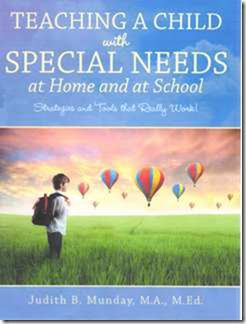Teaching a Child with Special Needs: Book Review

Book review by Kathy Kuhl
Judith Munday’s new book is out at last: Teaching a Child with Special Needs at Home and at School. That’s good news for homeschoolers with children with learning challenges.

Back in the 1990s, when I was a new homeschooler, Judi was the first expert I heard who understood homeschooling students with special needs. As a new homeschooler, I was eager to learn. Judi, with her years of experience teaching special education and her heart for and experience helping homeschoolers, got down into the practical details of goal setting, accommodations, and modifications, while other experts without classroom experience did not. Judi has spoken at homeschool conventions around the country. She has poured some of her expertise into this practical, detailed volume, giving us many nuts and bolts of teaching a child with special needs.
The book reads like a good introductory special education course for homeschoolers. Judi clearly wants to help parents in this task, and the details of what to teach are punctuated with encouragement.
“Effective Instruction” is an important chapter, especially for parents without any teacher training. It not only tells how to teach—present the lesson objective first, link new to prior learning, use clear examples, teach in an orderly sequence, analyze performance continuously, and much more. Better yet, it tells why each of these is important and how to do teach one.
The chapter on Bloom’s taxonomy of learning is fundamental to her book. Bloom’s taxonomy, commonly taught in education courses, defines learning in six different levels of thinking skills. From easy to hard, I list them below with some example questions:
- Know (recall facts): “Name one thing that Harold drew with his purple crayon.”
- Comprehend: “Was Henny Penny right to think that the sky was falling?”
- Apply (to new situation): “What would have happened if the third little pig talked his brothers into living with him in his brick house?”
- Analyze (break down information): “Compare the different building materials the three little pigs used.”
- Synthesize: put information together in a new way. “Create a brochure written by an imaginary American patriot giving citizens of your town reasons to join the revolution.”
- Evaluate: judge. “Decide how the colonies might have responded if Britain had continued taxing them but allowed them representation in Parliament.”
This chapter explains these in more detail, tells why they are important, and provides good examples. It shows how to use these levels to adapt assignments to your child’s abilities.
Other chapters include practical advice on:
- Choosing and using curriculum
- Accommodations and modifications to curriculum
- Assistive technology
- Four critical steps in the learning process
- Study strategies for memorizing, reading, vocabulary, spelling, math
- Graphic organizers
- Evaluating student work
- Using rubrics to evaluate tasks
- When to seek professional help
In the appendix, she gives resources, sample graphic organizers, rubrics and other tools.
For those who need an introduction to different kinds of special needs, the author also provides chapters on:
- Language-based learning disabilities
- Autism-spectrum disorders
- Dyslexia, dyscalculia, and dysgraphia
Reading this book is like having a veteran special education teacher who loves homeschooling sit down with you to give you the benefits of her expertise. I recommend Judi Munday’s Teaching a Child with Special Needs. Click here to see it on Amazon.
Disclosure: Judith Munday gave me a copy this book for review. I only recommend books and services I find helpful.
Judi and I have presented together at the Learning Disabilities Association National Conference in Baltimore, and on panels at the HEAV homeschool convention in Richmond. She has retired but is still helping parents and giving a few consultations by phone. Visit her website to learn more or to contact her.

